简述多喷嘴对置式水煤浆气化技术的工艺流程
- 格式:doc
- 大小:29.45 KB
- 文档页数:5
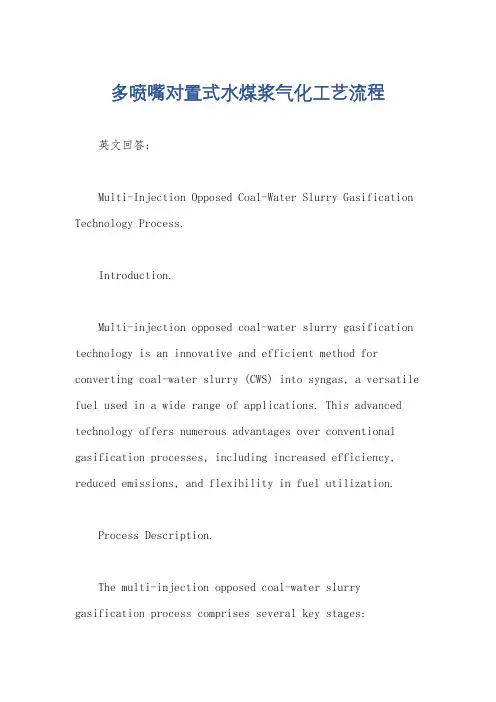
多喷嘴对置式水煤浆气化工艺流程英文回答:Multi-Injection Opposed Coal-Water Slurry Gasification Technology Process.Introduction.Multi-injection opposed coal-water slurry gasification technology is an innovative and efficient method for converting coal-water slurry (CWS) into syngas, a versatile fuel used in a wide range of applications. This advanced technology offers numerous advantages over conventional gasification processes, including increased efficiency, reduced emissions, and flexibility in fuel utilization.Process Description.The multi-injection opposed coal-water slurry gasification process comprises several key stages:1. Slurry Preparation: Coal is crushed and blended with water to form a homogeneous coal-water slurry.2. Injection: The CWS is injected into the gasification reactor through multiple nozzles.3. Reaction: The CWS undergoes a series of chemical reactions in the reactor, including pyrolysis, gasification, and combustion.4. Syngas Production: The product of the gasification process is syngas, a mixture of hydrogen, carbon monoxide, and other gases.5. Purification: The syngas is purified to remove impurities and contaminants.6. End Use: The purified syngas can be used as a fuelfor various applications, such as power generation,industrial heating, and transportation.Advantages of Multi-Injection Opposed Coal-Water Slurry Gasification.High Efficiency: The multi-injection design optimizes reaction conditions, leading to more efficient conversion of CWS into syngas.Low Emissions: The technology minimizes emissions of pollutants, such as sulfur dioxide and nitrogen oxides, by controlling combustion and utilizing advanced purification techniques.Fuel Flexibility: The gasification process can handle a wide range of coal types and qualities, providing operational flexibility.Compact Design: The reactor design is compact and modular, allowing for easier installation and maintenance.Economic Viability: The technology offers competitive operating costs and potential revenue streams from syngas utilization.Applications.Multi-injection opposed coal-water slurry gasification technology has a broad range of applications, including:Power Generation: Syngas can be used as a clean and efficient fuel for power plants.Industrial Heating: Syngas can be utilized forindustrial processes that require high-temperature heat.Hydrogen Production: The syngas can be processed to extract hydrogen, a valuable clean fuel.Chemical Feedstock: Syngas is an essential feedstockfor the production of various chemicals and pharmaceuticals.Environmental Impact.Multi-injection opposed coal-water slurry gasification technology has a positive impact on the environment:Reduced Carbon Emissions: By converting coal into syngas, the technology reduces carbon dioxide emissions compared to direct coal combustion.Air Pollution Control: Advanced purification techniques effectively remove pollutants from the syngas, mitigating air pollution.Sustainable Fuel Source: The utilization of coal-water slurry provides a sustainable fuel option for various industries.Conclusion.Multi-injection opposed coal-water slurry gasification technology is a promising and environmentally friendly solution for converting coal into a versatile fuel source. Its high efficiency, low emissions, and fuel flexibility make it an attractive option for a wide range of applications. As the demand for clean and sustainable energy sources grows, this innovative technology is poisedto play a significant role in the energy transition.中文回答:多喷嘴对置式水煤浆气化工艺流程。

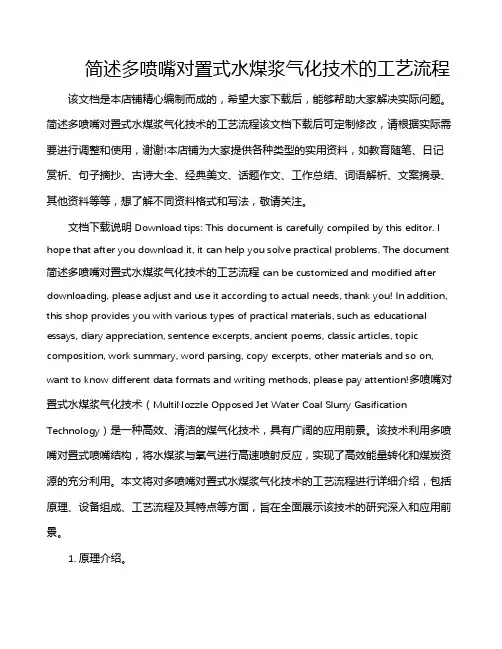
简述多喷嘴对置式水煤浆气化技术的工艺流程该文档是本店铺精心编制而成的,希望大家下载后,能够帮助大家解决实际问题。
简述多喷嘴对置式水煤浆气化技术的工艺流程该文档下载后可定制修改,请根据实际需要进行调整和使用,谢谢!本店铺为大家提供各种类型的实用资料,如教育随笔、日记赏析、句子摘抄、古诗大全、经典美文、话题作文、工作总结、词语解析、文案摘录、其他资料等等,想了解不同资料格式和写法,敬请关注。
文档下载说明Download tips: This document is carefully compiled by this editor. I hope that after you download it, it can help you solve practical problems. The document 简述多喷嘴对置式水煤浆气化技术的工艺流程can be customized and modified after downloading, please adjust and use it according to actual needs, thank you! In addition, this shop provides you with various types of practical materials, such as educational essays, diary appreciation, sentence excerpts, ancient poems, classic articles, topic composition, work summary, word parsing, copy excerpts, other materials and so on, want to know different data formats and writing methods, please pay attention!多喷嘴对置式水煤浆气化技术(MultiNozzle Opposed Jet Water Coal Slurry Gasification Technology)是一种高效、清洁的煤气化技术,具有广阔的应用前景。
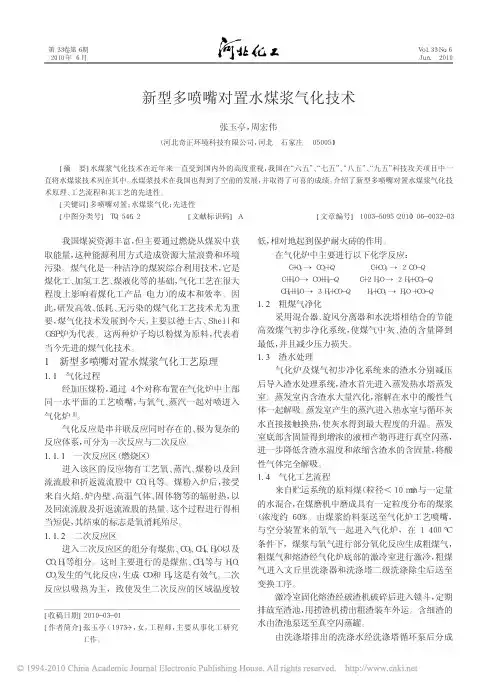

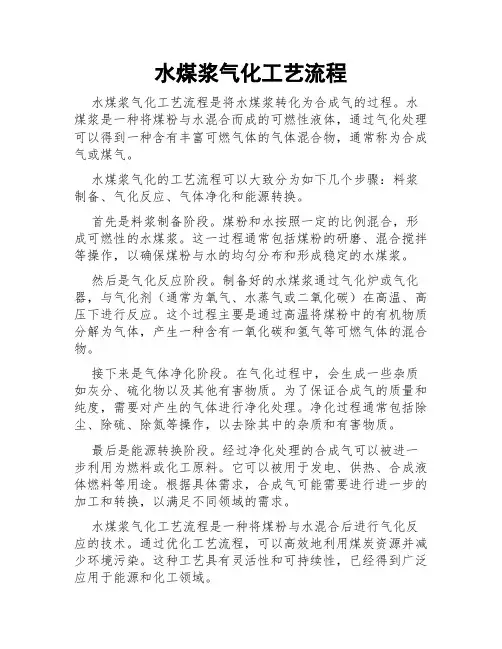
水煤浆气化工艺流程
水煤浆气化工艺流程是将水煤浆转化为合成气的过程。
水煤浆是一种将煤粉与水混合而成的可燃性液体,通过气化处理可以得到一种含有丰富可燃气体的气体混合物,通常称为合成气或煤气。
水煤浆气化的工艺流程可以大致分为如下几个步骤:料浆制备、气化反应、气体净化和能源转换。
首先是料浆制备阶段。
煤粉和水按照一定的比例混合,形成可燃性的水煤浆。
这一过程通常包括煤粉的研磨、混合搅拌等操作,以确保煤粉与水的均匀分布和形成稳定的水煤浆。
然后是气化反应阶段。
制备好的水煤浆通过气化炉或气化器,与气化剂(通常为氧气、水蒸气或二氧化碳)在高温、高压下进行反应。
这个过程主要是通过高温将煤粉中的有机物质分解为气体,产生一种含有一氧化碳和氢气等可燃气体的混合物。
接下来是气体净化阶段。
在气化过程中,会生成一些杂质如灰分、硫化物以及其他有害物质。
为了保证合成气的质量和纯度,需要对产生的气体进行净化处理。
净化过程通常包括除尘、除硫、除氮等操作,以去除其中的杂质和有害物质。
最后是能源转换阶段。
经过净化处理的合成气可以被进一步利用为燃料或化工原料。
它可以被用于发电、供热、合成液体燃料等用途。
根据具体需求,合成气可能需要进行进一步的加工和转换,以满足不同领域的需求。
水煤浆气化工艺流程是一种将煤粉与水混合后进行气化反应的技术。
通过优化工艺流程,可以高效地利用煤炭资源并减少环境污染。
这种工艺具有灵活性和可持续性,已经得到广泛应用于能源和化工领域。
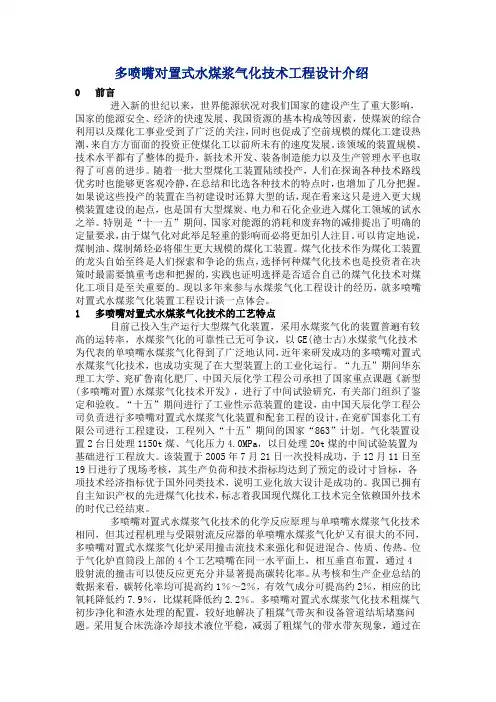
多喷嘴对置式水煤浆气化技术工程设计介绍0 前言进入新的世纪以来,世界能源状况对我们国家的建设产生了重大影响,国家的能源安全、经济的快速发展、我国资源的基本构成等因素,使煤炭的综合利用以及煤化工事业受到了广泛的关注,同时也促成了空前规模的煤化工建设热潮,来自方方面面的投资正使煤化工以前所未有的速度发展。
该领域的装置规模、技术水平都有了整体的提升,新技术开发、装备制造能力以及生产管理水平也取得了可喜的进步。
随着一批大型煤化工装置陆续投产,人们在探询各种技术路线优劣时也能够更客观冷静,在总结和比选各种技术的特点时,也增加了几分把握。
如果说这些投产的装置在当初建设时还算大型的话,现在看来这只是进入更大规模装置建设的起点,也是国有大型煤炭、电力和石化企业进入煤化工领域的试水之举。
特别是“十一五”期间,国家对能源的消耗和废弃物的减排提出了明确的定量要求,由于煤气化对此举足轻重的影响而必将更加引人注目。
可以肯定地说,煤制油、煤制烯烃必将催生更大规模的煤化工装置。
煤气化技术作为煤化工装置的龙头自始至终是人们探索和争论的焦点,选择何种煤气化技术也是投资者在决策时最需要慎重考虑和把握的,实践也证明选择是否适合自己的煤气化技术对煤化工项目是至关重要的。
现以多年来参与水煤浆气化工程设计的经历,就多喷嘴对置式水煤浆气化装置工程设计谈一点体会。
1 多喷嘴对置式水煤浆气化技术的工艺特点目前己投入生产运行大型煤气化装置,采用水煤浆气化的装置普遍有较高的运转率,水煤浆气化的可靠性已无可争议,以GE(德士古)水煤浆气化技术为代表的单喷嘴水煤浆气化得到了广泛地认同,近年来研发成功的多喷嘴对置式水煤浆气化技术,也成功实现了在大型装置上的工业化运行。
“九五”期间华东理工大学、兖矿鲁南化肥厂、中国天辰化学工程公司承担了国家重点课题《新型(多喷嘴对置)水煤浆气化技术开发》,进行了中间试验研究,有关部门组织了鉴定和验收。
“十五”期间进行了工业性示范装置的建设,由中国天辰化学工程公司负责进行多喷嘴对置式水煤浆气化装置和配套工程的设计,在兖矿国泰化工有限公司进行工程建设,工程列入“十五”期间的国家“863”计划。
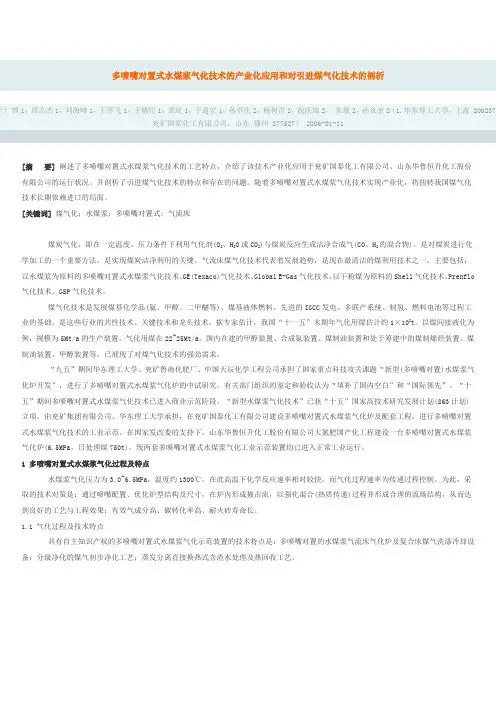
多喷嘴对置式水煤浆气化技术的产业化应用和对引进煤气化技术的剖析于广锁1,周志杰1,刘海峰1,王亦飞1,王辅臣1,龚欣1,于遵宏1,孙卓庆2,杨树青2,祝庆瑞2,朱敏2,孙永奎2(1.华东理工大学,上海 200237;兖矿国泰化工有限公司,山东滕州 277527) 2006-01-11[摘要] 阐述了多喷嘴对置式水煤浆气化技术的工艺特点,介绍了该技术产业化应用于兖矿国泰化工有限公司、山东华鲁恒升化工股份有限公司的运行状况。
并剖析了引进煤气化技术的特点和存在的问题。
随着多喷嘴对置式水煤浆气化技术实现产业化,将扭转我国煤气化技术长期依赖进口的局面。
[关键词] 煤气化;水煤浆;多喷嘴对置式;气流床煤炭气化,即在一定温度、压力条件下利用气化剂(O2、H2O或CO2)与煤炭反应生成洁净合成气(CO、H2的混合物),是对煤炭进行化学加工的一个重要方法,是实现煤炭洁净利用的关键。
气流床煤气化技术代表着发展趋势,是现在最清洁的煤利用技术之一,主要包括:以水煤浆为原料的多喷嘴对置式水煤浆气化技术、GE(Texaco)气化技术、Global E-Gas气化技术,以干粉煤为原料的Shell气化技术、Prenflo气化技术、GSP气化技术。
煤气化技术是发展煤基化学品(氨、甲醇、二甲醚等)、煤基液体燃料、先进的IGCC发电、多联产系统、制氢、燃料电池等过程工业的基础,是这些行业的共性技术、关键技术和龙头技术。
据专家估计,我国“十一五”末期年气化用煤估计约1×108t。
以煤间接液化为例,规模为5Mt/a的生产装置,气化用煤在22~25Mt/a。
国内在建的甲醇装置、合成氨装置、煤制油装置和处于筹建中的煤制烯烃装置、煤制油装置、甲醇装置等,已展现了对煤气化技术的强劲需求。
“九五”期间华东理工大学、兖矿鲁南化肥厂、中国天辰化学工程公司承担了国家重点科技攻关课题“新型(多喷嘴对置)水煤浆气化炉开发”,进行了多喷嘴对置式水煤浆气化炉的中试研究。
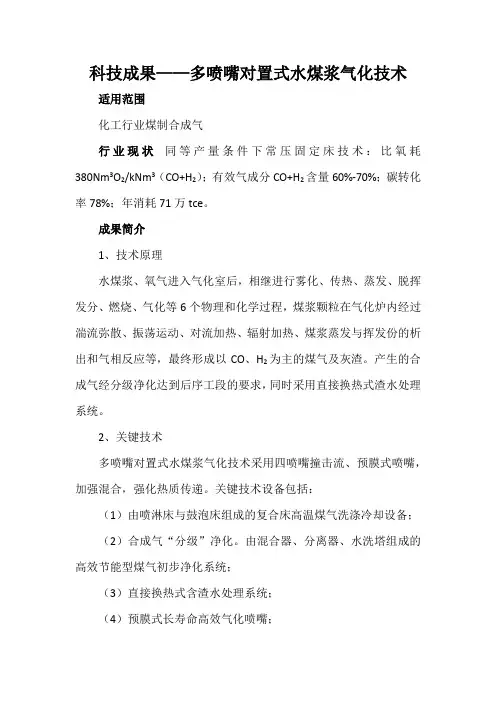
科技成果——多喷嘴对置式水煤浆气化技术适用范围化工行业煤制合成气行业现状同等产量条件下常压固定床技术:比氧耗380Nm3O2/kNm3(CO+H2);有效气成分CO+H2含量60%-70%;碳转化率78%;年消耗71万tce。
成果简介1、技术原理水煤浆、氧气进入气化室后,相继进行雾化、传热、蒸发、脱挥发分、燃烧、气化等6个物理和化学过程,煤浆颗粒在气化炉内经过湍流弥散、振荡运动、对流加热、辐射加热、煤浆蒸发与挥发份的析出和气相反应等,最终形成以CO、H2为主的煤气及灰渣。
产生的合成气经分级净化达到后序工段的要求,同时采用直接换热式渣水处理系统。
2、关键技术多喷嘴对置式水煤浆气化技术采用四喷嘴撞击流、预膜式喷嘴,加强混合,强化热质传递。
关键技术设备包括:(1)由喷淋床与鼓泡床组成的复合床高温煤气洗涤冷却设备;(2)合成气“分级”净化。
由混合器、分离器、水洗塔组成的高效节能型煤气初步净化系统;(3)直接换热式含渣水处理系统;(4)预膜式长寿命高效气化喷嘴;(5)结构新颖的交叉流式洗涤水分布器;(6)国内首次成功实施停运气化烧嘴在线带压投料的操作技术。
3、工艺流程通过喷嘴对置、优化炉型结构及尺寸,在炉内形成撞击流,以强化混合和热质传递过程,并形成炉内合理的流场结构。
主要包括煤浆制备、输送单元,多喷嘴对置式水煤浆气化单元,煤气初步净化单元和含渣水处理单元,其中关键单元为气化、煤气初步净化和含渣水热回收。
图1 多喷嘴对置式水煤浆气化工艺流程图主要技术指标与引进的水煤浆气化技术相比,采用该技术可使比氧耗降低7.9%,比煤耗降低2.2%。
以北宿煤为原料,合成气有效气成分(CO+H2)含量84.9%,比氧耗309Nm3O2/1000Nm3(CO+H2),降低7.9%;比煤耗535kg/1000Nm3(CO+H2),降低 2.2%;碳转化率98.8%,提高2%-3%;产气率2.20Nm3/kg;有效气成分提高2%-3%;CO2含量降低2%-3%。

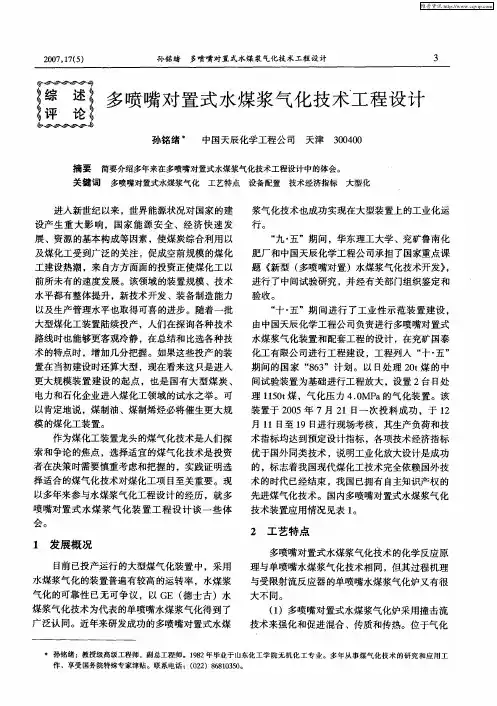
多喷嘴对置式水煤浆气化流程一、引言多喷嘴对置式水煤浆气化是一种高效利用煤炭资源的气化技术,其通过将水煤浆喷嘴垂直对置,使喷嘴之间的气化反应得到充分利用,提高气化效率。
二、多喷嘴对置式水煤浆气化流程1. 煤炭破碎和干燥:将原料煤炭进行破碎和干燥处理,以提高煤炭的可燃性和流动性。
2. 水煤浆制备:将破碎和干燥后的煤炭与适量的水混合,制备成水煤浆,以提高煤炭的可泵性和传输性。
3. 进料系统:将制备好的水煤浆通过泵送至气化炉的进料系统。
4. 喷嘴系统:多喷嘴对置式水煤浆气化的核心部分是喷嘴系统。
喷嘴系统通常由多个喷嘴组成,这些喷嘴垂直对置,形成一个喷嘴阵列。
喷嘴的数量和布置方式可以根据实际需求进行设计。
5. 气化炉:水煤浆通过进料系统进入气化炉,喷嘴系统将水煤浆喷入气化炉内。
在气化炉内,水煤浆与气化剂(通常是氧气或蒸汽)发生反应,产生可燃气体和灰渣。
6. 气体处理:从气化炉中产生的可燃气体经过净化处理,去除其中的硫化物、氮氧化物和颗粒物等杂质,以提高气体的纯度和热值。
7. 热能回收:在气体处理过程中,通过余热回收装置,将气体中的热能回收利用,用于加热水煤浆或产生蒸汽等。
8. 产品分离:经过气体处理和热能回收后的可燃气体可以用于发电、制取合成气等用途。
而气化炉中产生的灰渣可以通过分离装置进行分离,其中的可燃物质可以作为燃料继续利用,而其他固体废弃物则需要进行处理和处置。
三、多喷嘴对置式水煤浆气化的优势1. 高效利用煤炭资源:多喷嘴对置式水煤浆气化能够将煤炭中的可燃气体充分释放出来,提高煤炭的利用效率。
2. 灵活性高:多喷嘴对置式水煤浆气化技术适用于不同种类的煤炭,具有较高的适应性和灵活性。
3. 环保节能:多喷嘴对置式水煤浆气化过程中,通过热能回收装置回收余热,提高能源利用效率,减少对环境的影响。
4. 产品多样化:多喷嘴对置式水煤浆气化可以产生多种产品,如合成气、发电、燃料气等,具有较广泛的应用前景。
四、结论多喷嘴对置式水煤浆气化是一种高效利用煤炭资源的气化技术,其具有高效利用煤炭资源、灵活性高、环保节能和产品多样化等优势。
多喷嘴对置式水煤浆气化技术随着我国工业化的不断进步和发展,我国对于能源的需求量也与日俱增,而我国的能源整体特点是多煤缺油少气,这就迫使我国每年需要大量的进口石油以及天然气等资源来满足工业及经济发展需求。
随着国家能源市场的变动及制约,我国需要根据我国资源特点进行研究,开发出新的煤炭利用技术以满足我国的能源需求。
在“九五”期间,华东理工大学及兖矿集团有限公司通过全面的产学研合作开发出了一种新型的水煤浆气化炉—多喷嘴对置式水煤浆气化炉,这一技术的出现极大的提供了对于煤炭资源的利用程度。
本文主要对多喷嘴对置式水煤浆气化炉技术和优势进行简要介绍,并对其发展方向和存在的一些问题进行简要概述。
标签:多喷嘴;对置式;水煤浆气化0 引言随着我国工业化发展进程的加速,我国对于能源的需求量十分庞大,世界三大能源中的煤炭、石油和天然气中,我国只具有丰富的煤炭矿藏,而石油和天然气都处于稀少的状态。
这些条件都使得我国对于煤炭资源的开发和利用极为重视,煤炭资源的高效、深度利用对于我国的发展具有十分重要的战略意义。
其中煤气化技术又是其他多个工业行业的重要基础,煤气化后可以作为燃气、发电发热、液化等多种用途。
我国自主研发的多喷嘴对置式水煤浆气化技术极大的促进了我国煤化工产业的发展,也给我们的能源高效利用提供了很好的示范,这一技术的大规模使用也标志了我国的水煤浆气化技术已经处于国际先进水平。
1 多喷嘴对置式水煤浆气化技术1.1 技术简介多喷嘴对置式水煤浆气化技术其实本质是一种气流床气化技术,以大规模的煤炭高效气化技术为基础,将煤炭的深度加工与多种清洁能源生产进行结合的一种大型加压煤化工设备。
气化技术一种重要的煤炭高效利用的技术,可以将煤炭进行深度化学转化,生成天然气等多种清洁能源,现阶段已经成为煤化工产业的核心技术。
气流床气化技术是煤炭气化中最成熟的技术。
我国早期引进的是国外的德士古水煤浆气化设备,随着多喷嘴对置式水煤浆气化技术和设备的研发,我国的煤炭气化产业得到了快速的发展。
多喷嘴对置式水煤浆气化技术简介多喷嘴对置式水煤浆气化技术是一种高效能的煤炭资源利用技术。
该技术通过将水煤浆喷射到气化装置中,利用高温和高压条件下的热化学反应,将煤炭转化为合成气和其他有用的化学品。
多喷嘴对置式水煤浆气化技术相比传统的气化技术有许多优势,可以提高气化效率、降低煤炭消耗量,并且能够适应各种煤种的气化。
原理多喷嘴对置式水煤浆气化技术主要由气化装置和燃料供应系统组成。
气化装置气化装置是该技术的核心部件,通常由多个喷嘴和反应器组成。
多喷嘴的设计可以提高煤炭与氧气的接触面积,增加气化反应的速率。
喷嘴之间的对置设计可以增加反应器的稳定性,避免局部过渡状况的发生。
气化装置的结构可以根据具体的应用需求进行调整和优化。
燃料供应系统燃料供应系统主要负责将水煤浆输送到气化装置中。
该系统通常包括水煤浆的储存罐、输送管道和喷嘴。
水煤浆进入喷嘴后,通过气化装置内的高温和高压气氛下的热化学反应,将煤炭转化为合成气和灰渣。
合成气可以用作燃料或用于其他化学工艺过程。
优势多喷嘴对置式水煤浆气化技术具有以下优势:1.提高气化效率:多喷嘴的设计可以增加煤炭与氧气的接触面积,加快气化反应的速率,从而提高气化效率。
2.降低煤炭消耗量:由于气化效率的提高,该技术相比传统气化技术可以降低煤炭的消耗量,减少煤炭资源的浪费。
3.适应性强:多喷嘴对置式水煤浆气化技术可以适应各种煤种的气化,包括高灰分煤和高硫煤等。
这使得该技术在煤炭资源利用方面具有广泛的应用前景。
4.灵活性高:多喷嘴对置式水煤浆气化技术可以根据实际应用需求进行灵活调整和优化。
喷嘴的数量和布置方式可以根据气化反应器的尺寸和工艺要求进行设计,提高技术的适应性。
应用多喷嘴对置式水煤浆气化技术在能源领域具有广泛的应用前景。
它可以利用煤炭等化石燃料资源,产生合成气和其他有价值的化学品。
合成气可以用作燃料,取代传统的煤炭燃烧方式,减少环境污染。
此外,合成气还可以用于化学工业和合成燃料的生产,具有较大的市场潜力。
简述多喷嘴对置式水煤浆气化技术的工艺
流程
The process flow of multi-nozzle opposed jet coal-water slurry gasification technology can be summarized as follows:
Raw Material Preparation:
In this step, the coal and water are mixed to form a coal-water slurry. The coal is pulverized into fine particles to enhance its reactivity during gasification. The water content in the slurry should be carefully controlled to ensure optimal flowability and gasification performance.
Feed System:
The coal-water slurry is then fed into a high-pressure feed system, where it is pressurized before entering the gasifier. This ensures that the slurry flows smoothly and evenly through the multiple nozzles without any blockages
or interruptions.
Gasifier:
The heart of the process is the gasifier, where the coal-
water slurry undergoes gasification to produce synthetic gas (syngas). The syngas consists primarily of carbon monoxide (CO), hydrogen (H2), and other trace gases. The multi-nozzle configuration plays a crucial role here, as it allows for efficient distribution of the slurry and promotes thorough mixing with gaseous reactants. This enhances combustion characteristics and facilitates better heat transfer, leading to improved overall performance of the gasifier.
Syngas Cleanup:
After leaving the gasifier, the syngas contains impurities such as sulfur compounds, particulate matter, and tar. These contaminants need to be removed before utilizing the syngas for various applications such as power generation or chemical synthesis. Therefore, a syngas cleanup system is incorporated into the process flow. It typically includes processes like scrubbing, filtering, and catalytic conversion to purify the syngas prior to its end use.
Heat Recovery:
During gasification, a significant amount of thermal energy
is released from exothermic reactions. To maximize energy efficiency, heat recovery systems are employed in conjunction with multi-nozzle opposed jet coal-water slurry gasifiers. These systems capture and utilize the heat, which would otherwise be wasted, for various purposes such as preheating the incoming feed, generating steam, or supplying heat to other industrial processes.
Integration with Power Generation or Chemical Production: The purified syngas can be utilized for power generation by combusting it in gas turbines or internal combustion engines. Alternatively, it can serve as a valuable feedstock for the production of chemicals like methanol, ammonia, or synthetic fuels. The versatility of multi-nozzle opposed jet coal-water slurry gasification technology allows for integration with different downstream applications based on specific requirements.
总结:
多喷嘴对置式水煤浆气化技术的工艺流程可以总结如下:
1.原料准备:将煤和水混合形成水煤浆,煤要细碎以增强其气化反
应性能,同时要控制好水分含量以确保良好的流动性和气化性能。
2.进料系统:将水煤浆送入高压供料系统,在进入气化器之前进行
加压处理,以确保水煤浆在多个喷嘴间平稳均匀地流动,避免阻塞
或中断。
3.气化器:气化器是整个过程的核心部件,水煤浆在此进行气化反
应生成合成气(syngas)。
合成气主要由一氧化碳(CO)、氢(H2)及其他微量杂质组成。
多喷嘴对置式配置在此起着至关重要的作用,能够有效分配水煤浆并促进其与气态反应物混合,提高燃烧特性和
热传递效率,从而改善气化器的整体性能。
4.合成气净化:离开气化器的合成气含有硫化物、颗粒物和焦油等
杂质。
因此,在工艺流程中需要引入合成气净化系统,通过洗涤、
过滤和催化转化等过程来净化合成气,以便将其应用于发电或化学
合成等各种领域。
5.热能回收:在气化过程中会释放大量的热能。
为了最大限度地提
高能源利用效率,多喷嘴对置式水煤浆气化技术通常会与热能回收
系统结合使用。
这些系统可以捕获并利用本来会被浪费掉的热能,
用于预热进料、产生蒸汽或供给其他工业过程所需的热量。
6.与发电或化工生产集成:净化后的合成气可通过在燃气轮机或内燃机中完全燃烧来发电,也可以作为制造甲醇、氨或合成燃料等化学品的宝贵原料。
多喷嘴对置式水煤浆气化技术的灵活性使其能够与不同的下游应用集成,以满足特定需求。